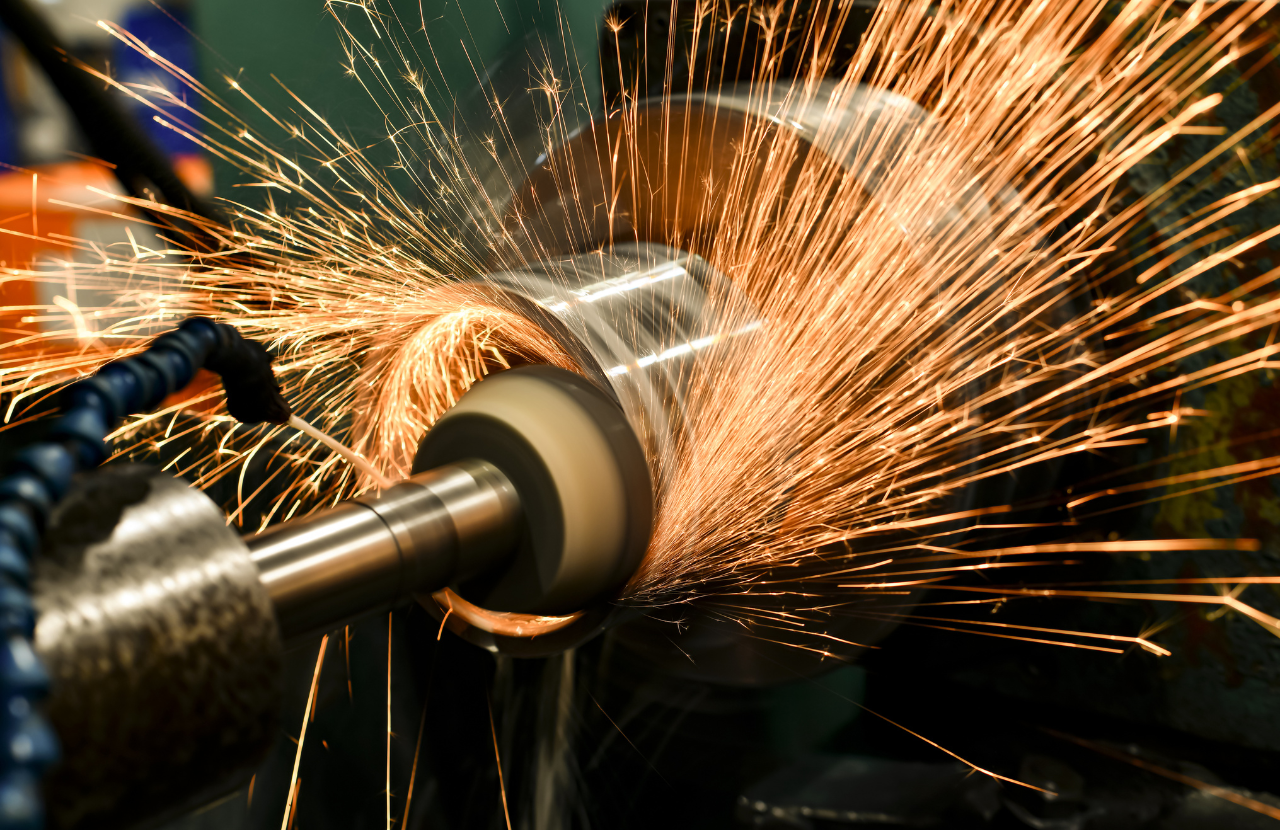
Abrasive wheels are commonly used in grinding machines to remove material, sharpen tools, create shapes, or finish surfaces. Here is a detailed explanation of the types of abrasive wheels (also called ‘grinding wheels’) and their practical applications.
Types of abrasive wheels
These are the main types of abrasive wheels used in the UK:
Straight wheels
Description
Shape: Flat and circular with a central hole for mounting.
Abrasive: Typically made of aluminium oxide, silicon carbide and other abrasive materials.
Edge: The grinding edge is straight and parallel to the axis of the wheel.
Uses
Surface grinding: Ideal for surface grinding operations where a flat, smooth finish is required.
Tool sharpening: Used to sharpen tools such as chisels, knives and drill bits.
General purpose: Suitable for most general grinding tasks, including deburring and cleaning metal surfaces.
Cylinder wheels
Description
Shape: Large, hollow cylindrical wheels with a consistent diameter.
Abrasive: Made from the same materials as other abrasive wheels, including aluminium oxide and silicon carbide.
Edge: The grinding surface is the cylindrical face of the wheel.
Uses
Surface grinding: Used primarily for surface grinding on large flat surfaces.
High volume grinding: Effective for high-volume material removal and surface finishing.
Machine components: Often used in grinding operations involving large machine parts.
Tapered wheels
Description
Shape: Similar to straight wheels but with a tapering edge towards one side.
Abrasive: Composed of various abrasive materials suitable for the specific grinding task.
Edge: The edge tapers, allowing for precision grinding at different angles.
Uses
Precision grinding: Ideal for precision grinding of angles and tapering surfaces.
Tool and die work: Used in tool and die shops for creating and maintaining intricate shapes and profiles.
Contoured surfaces: Suitable for grinding contoured surfaces and for operations requiring a specific angle.
Straight cup wheels
Description
Shape: Resemble a cup with a flat bottom and straight, vertical sides.
Abrasive: Made from various abrasive materials like aluminium oxide and silicon carbide.
Edge: The grinding surface is on the bottom face of the cup.
Uses
Surface grinding: Commonly used for surface grinding applications where a flat, smooth finish is needed.
Tool sharpening: Ideal for sharpening tools where a flat edge is required.
Grinding flat surfaces: Effective for grinding flat surfaces on smaller workpieces.
Dish wheels
Description
Shape: Shaped like a shallow dish with a wide, flat base and a slightly concave grinding surface.
Abrasive: Constructed from various abrasive materials, depending on the application.
Edge: The grinding surface is the concave face of the wheel.
Uses
Tool sharpening: Commonly used for sharpening tools with complex shapes, such as gear teeth.
Precision grinding: Suitable for precision grinding tasks where a concave surface is beneficial.
Die work: Utilised in die shops for creating and maintaining intricate tool shapes.
Saucer wheels
Description
Shape: Resemble a saucer or shallow bowl with a wide, flat base and angled sides.
Abrasive: Made from a variety of abrasive materials, such as aluminium oxide and silicon carbide.
Edge: The grinding surface is the wide, flat base with angled sides.
Uses
Tool sharpening: Particularly effective for sharpening saw blades and other cutting tools.
Corner grinding: Ideal for grinding in corners and for operations requiring access to tight spaces.
Deburring: Used for deburring and removing material from intricate and hard-to-reach areas.
Types of grinding wheel machines
Each type of grinding wheel machine has a specialised use. This makes them indispensable tools in all kinds of industrial and workshop settings. Proper utilisation of these machines enhances efficiency, precision, and the quality of the work produced.
Here are some of the most common abrasive wheel machines and what they are used for.
Angle grinders
- Cutting. Used to cut through metal, stone, tile, and concrete. Equipped with cutting discs, they can handle a variety of materials.
- Grinding. Used to remove excess material, smooth rough edges, and clean welds. Grinding discs and flap discs are common attachments.
- Sanding and polishing. With the appropriate attachments, angle grinders can also be used for sanding and polishing surfaces.
- Sharpening tools. Although not as common, they can be used to sharpen tools when fitted with the correct disc.
Belt grinders
- Metalworking. Ideal for deburring, shaping, and finishing metal parts. They can handle heavy-duty grinding tasks.
- Woodworking. Used for shaping, smoothing, and finishing wood. They are effective for removing large amounts of material quickly.
- Knife making. Belt grinders are popular in the knife-making community for shaping blades and handles.
- Tool sharpening. Effective for sharpening tools and blades to a precise edge.
Bench grinders
- Tool sharpening. Commonly used to sharpen tools such as chisels, drill bits, and lawnmower blades.
- Grinding and shaping metal. Used for grinding, shaping, and smoothing metal parts and components.
- Removing rust and paint. Equipped with wire wheels, bench grinders can remove rust, paint, and corrosion from metal surfaces.
- Polishing. With the right attachment, bench grinders can be used for polishing metal and plastic surfaces.
Jig grinders
- Precision hole grinding. Used for grinding precise holes and intricate shapes in metal parts.
- Die and mould making. Essential in the manufacture of dies and moulds, providing high accuracy and fine finishes.
- Component repair. Utilised in repairing and refurbishing complex machine components to precise specifications.
- Surface finishing. Achieves high-quality surface finished on intricate parts.
Surface grinders
- Creating flat surfaces. Used to produce extremely flat surfaces on metal and non-metallic materials.
- Finishing precision parts. Provides high-tolerance surface finishes, essential in tool and die making.
- Grinding large surfaces. Effective for grinding large, flat surfaces such as table tops and plates.
- Sharpening tools. Can be used to sharpen and finish tools, especially those requiring a flat edge.
Tool and cutter grinders
- Sharpening and cutting tools. Used to sharpen milling cutters, drills and other cutting tools to precise specifications.
- Grinding complex shapes. Capable of grinding complex shapes and angles required in cutting tools.
- Tool manufacturing. Essentia in the production and refurbishment of high-precision cutting tools.
- Maintaining tool quality. Ensures tools are kept sharp and in optimal condition, which is crucial for maintaining manufacturing quality and efficiency.
Abrasive Wheels Safety Training
Accidents with all types of abrasive wheels can cause horrific injuries. It is extremely important that employees understand how to keep themselves and others safe.
Our online Abrasive Wheels Training is designed to complement on the job training so that employees can identify hazards and know exactly what steps to take to mitigate risks. We offer bespoke options so training can be adapted to your organisation and roles. Training is available as eLearning or face-to-face at your workplace or another venue that suits you.
To find out what is covered in our Abrasive Wheels Training, please visit the course page or contact our friendly team today on 0203 011 4242/info@praxis42.com

Adam Clarke
Managing Director (Consulting)
